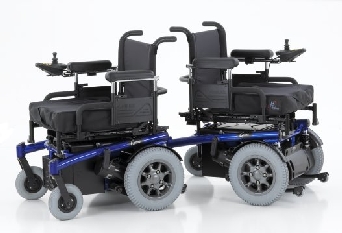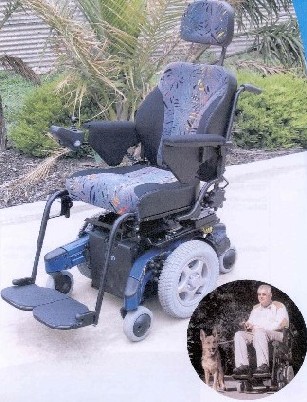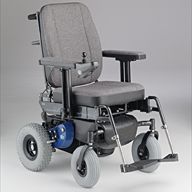More Details
Frame
* The frame and base is made from steel
* Tie down points are located at the front and rear of the base frame
* Anti tip bars are located at the rear
* The frame does not have suspension
Seat
* The seat is integrated with the base and is adjustable in depth via an allen key
* Width can be adjusted by moving the armrests outwards or inwards
* Alternative backrests, for example a Jay back can be fitted, however slung upholstery is standard
Backrest
* The backrest angle can recline manually by using a cord attached to locking pins on either side of the chair. There are four positions of recline. Power recline is an option
* The standard backrest upholstery is padded nylon and is tension adjustable
Headrest
A range of headrests are available
Armrests
* Armrests are full length, height adjustable and padded
* Swing away is optional.
Legrest
* Leg rests are swing away, removable and height adjustable
* Heavy duty leg rests are available
Footplates
* Two piece, lift up, plastic footplates are standard
* A range of options are available
Wheels
Drive wheels are 35.5cm in diameter and pneumatic
Castors
Front castors are 22.8cm in diameter and pneumatic
Controls
Penny and Giles VR2 controls are standard
Batteries
12 x2 volt deep-cycle batteries. 55AH (largest)
Motor
* 4 pole motors
* The motor can be disengaged by a lever on the base
Customisation
This wheelchair can be customised by using products in Prides other wheelchair ranges
Colours
Available in a silver frame only
Brakes
The braking system is electronic, regenerative disc brakes
Factors To Consider
Transport Accessibility
The space allowed on public transport for carrying mobility equipment is an area of 1300mm by 800mm.
Wheelchair spaces
All new Sydney buses feature special 'kneeling suspension' and a ramp to provide easy access for less mobile passengers.
There are spaces for two wheelchairs on the new buses. These will accommodate most manual and electric wheelchairs with maximum length 1250mm, maximum width 750mm, maximum turning circle1500mm and maximum weight 200kg.
For safety reasons, passengers in wheelchairs are advised to face the back of the bus, bracing their wheelchair against the side of the space, applying the brakes and securing the seat belt of the wheelchair.
Wheelchair accessible buses display a blue and white wheelchair sign on the front of the bus, and on the easy access door.
Occupied Wheelchair in a Car
A person sitting in a wheelchair within a car or van requires certification and RTA approval for the wheelchair and occupants restraint system where the wheelchair or occupant are restrained to the vehicle structure. RTA approval is not required for a postural support, such as a harness, that is only attached to the wheelchair and not to the vehicle.
Wheelchair Restraints
When transporting a person in a wheelchair in a car or van, both the occupant and the wheelchair require an RTA approved restraint system. The wheelchair and the occupant need to be separately secured to the vehicle itself.
RTA approval is not required for a postural support, such as a harness, that supports the user in the wheelchair but is not part of the vehicle restraint system.
The use of a headrest is not legally required but strongly recommended. Easily detachable, folding headrests which fit a wheelchair with standard push handles are available. Refer to section Wheelchair, Scooter, Cushions, ramps / Postural Supports - Seating System: Restraint+ Head+Back+Seats



 subscribers
subscribers 





